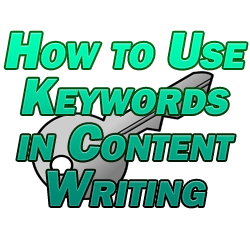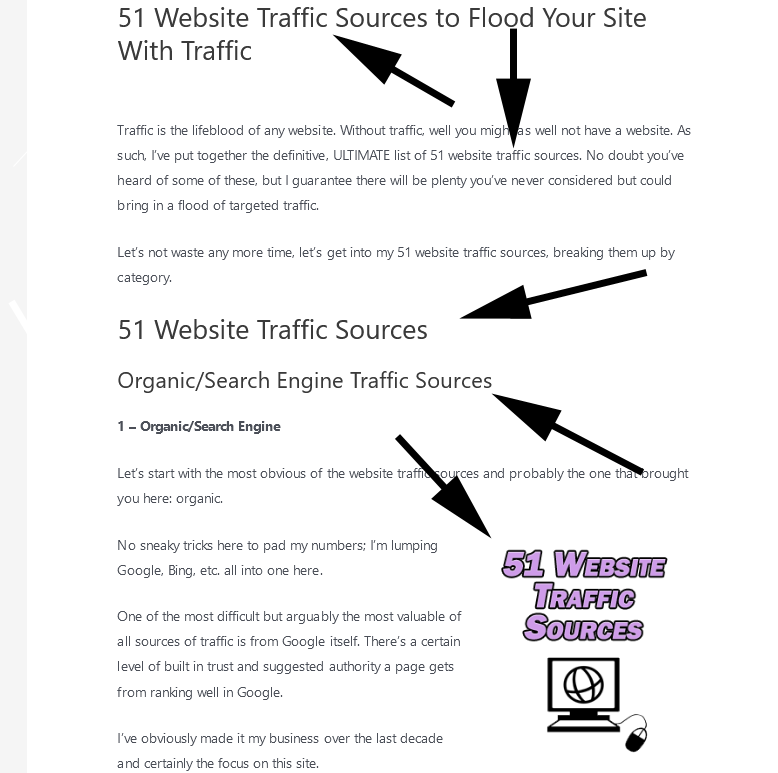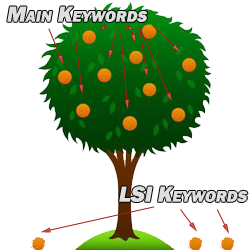
Content writing has become a big business in this modern age of the internet. Thankfully the hacks of 20 or even just 10 years ago to influence search engines aren’t nearly as effective as they once were. Instead, the path to ranking well as I revealed in my best SEO tip is through good content. Google is better than ever at letting its own users tell it what content is good and worth ranking well. Therefore, it’s essential that you know how to create quality content. Many companies have a content writer or writers on staff to keep their sites up to date, relevant, and attract more ranking opportunities and search traffic in Google.
A big part of content writing is keyword usage, though. Assuming you’re already making great content in your niche, you still might not know how to weave your keywords into your writing to help Google identify what your page is about.
Let’s talk about how to use keywords in content writing.
How to Use Keywords in Content Writing
Keyword Research
Before we get into how to use keywords in content writing, you should know how to find the best keywords to target.
First, you need a keyword tool to give you detailed information on your keywords to determine what’s worth targeting. These tools will show you information about each keyword like how many people search for them on average and how easily or otherwise the word or phrase is to rank for.
Refer to my free keyword tool review for reviews on my favorite free options, or check out my KeySearch review for an overview on what makes KeySearch my go to tool when searching for valuable keywords.
When using one of these tools, every keyword should be judged by three factors:
Volume
The number of people actually searching for that keyword. This is measured typically by monthly searches on average.
Some keywords are easy to rank well for simply because no one is searching for them. These keywords are obviously not worth your time.
How much search volume IS worth your time is relative from site to site.
If your site is relatively new, any traffic is valuable, so you should be open to targeting rarely searched for keywords. These keywords have their upsides as I’ll explain in a moment.
Competition
Competition is the strength of the other websites and their pages specifically which are ranking for the keyword at the moment.
It’s not worth your time to try to rank for a keyword if the strength of competition is beyond your reach. Any half decent tool will estimate the competition of a keyword and let you know how difficult it will be to rank for it.
Value
This is arguably the most important metric, and one which the keyword tool can’t explicitly give you a measurement on.
Value refers to the incalculable aspect of what ranking for that keyword will actually do for you and your website.
Let me better explain with an example.

According to KeySearch, “Guitar” gets 1.5 million searches a month. Ranking well for that keyword would be great due to the search volume, but the intent behind this search is too broad.
“Acoustic Guitar” gets 301,000 searches a month. So while it gets just 20% of the searches which “Guitar” gets, more specificity is where the value begins to assert itself.
Still, it’s a bit too vague when you think about the intent behind the search. This could range from people wanting to know about the history of the acoustic guitar, how to play it, or even how or where to buy one.
Let’s focus on that last idea.
“Acoustic Guitar For Sale” gets just 12,100 searches a month. But while the search volume is a tiny fraction of its parent keywords we just mentioned, we understand the intent behind that keyword and know that anyone searching for that is looking to spend some money.
If we were selling guitars, ranking well for this keyword could arguably make us more money than ranking well for more general/vague related keywords which aren’t worth nearly as much.
It’s just one example to show that intent and specificity are the two real keys to finding the best keywords.
I go into more detail in my overview on how to know what keywords to use for SEO, so refer to that for more information on keyword selection.
Let’s assume you now have the keyword you want to target and get back to how to use keywords in content writing.
One Keyword Per Page
First, only target one main keyword/idea per page.
I say keyword/idea, because you can include relevant keywords (which I’ll cover in a moment) alongside your content so long as they’re roughly interchangeable.
So while “how to change a baby’s diaper” and “how to get a baby to stop crying” are somewhat related in the childcare niche, these are two very different concepts/ideas. They are different enough to warrant two separate articles.
Conversely, while “how to change a baby’s diaper” and “how to change an infant’s diaper” are technically two different things, it doesn’t warrant two separate articles as its the same idea.
The more concepts which you target on a page, the less focused it becomes.
Google wants to be able to provide its users with a page which is laser focused on their search to resolve their problem.
This goes back to the concept of keyword value and understanding the intent behind every search before you sit down to create a page around it. Do that and the rest will take care of itself.
Where to Use Keywords in Content Writing
Let’s talk practical use in how to use keywords in content writing: where to put them.

Title
In addition to wanting to keep your article focused on one idea, there are some places where practically speaking you only have room enough to target one keyword.
The title is a perfect example. The title is the most important aspect of your article in more ways than one. Not only does Google place the most weight on it when identifying what your page is about, it also plays the largest role in dictating how many people will click your page in Google.
I talked about the importance of your title in my tutorial how to improve CTR in Google search.
Your keyword should absolutely be worked into your title either as the entire title or part of it (preferably at the start). When someone searches for their keyword, it will reassure them of your page’s relevance to their search when they see it included in the title.
URL
You can specify the URL for every new page or post you make in WordPress.
A good rule of thumb is to limit the URL to just your keyword.
So while your full title might be “How to Change a Diaper in 30 Seconds”, our keyword is just “how to change a diaper”. The “30 seconds” bit is just to encourage more clicks and help our title stand out; it doesn’t need to be in the URL.
In this case, we would make our URL slug for that page “how-to-change-a-diaper”.
Heading Tag
Typically by default, your title has the greatest weight in terms of heading tags. As such, it will appear as an H1 tag on your page in the eyes of Google.
Remember that Google gives content in heading tags more weight, so including your keyword or LSI keywords (more on this in a moment) in heading tags is a good idea.
Check out my recent tutorial on H1 H2 H3 SEO for more information on how to use headings effectively on your page with regards to SEO.
Description
Your page’s meta description is what appears below the title for your page in Google’s SERPs (search engine results pages).
Once again, your keyword should be featured somewhere in the description to reassure both search engines and people using them of your page’s relevance to that keyword. In many search engines, the keyword shows in bold letters in the description if included to help it stand out.
Alt Tag (Images)
Your main keyword should be featured in the alt tag of an image on that page. This both reinforces the context of that page and gives you a chance to rank for that keyword in the image search results, as well.
I name my main image after my keyword, as well. That said, it’s the alt tag which is the most important place to include that keyword. The content used in this tag will display if the image fails to load in a user’s browser.
Use relevant keywords in all of the hopefully relevant images which you include throughout that page, as well.
Other Media
It’s a good idea to embed a relevant video in your article, as well.
By now you should be getting the idea that a big part of how to use keywords in content writing is just getting your entire page in lockstep for that keyword. Using multiple types of media (images, videos, etc.) optimized for that same keyword helps to tie everything together.
You can check out my complete tutorial on SEO for Youtube for more information on how to optimize a video for your keyword.
Body
The keyword should obviously be used throughout the body of your article, as well. You want to be sure to include it initially near the top of the article, preferably in the first paragraph.
This is because search engines, just like people, read pages from the top down. They generally place more importance on the content at the beginning of the page as a result.
Best Keyword Density
Keyword density refers to what ratio of your article is your keyword compared to every other word. Keyword density has been debated since keywords became a thing.

In the early days of search engines, webmasters could stuff a page with their keyword without providing much or any value beyond that. Search engines subsequently would associate that page with that keyword and rank them accordingly.
Webmasters could then easily rank for whatever keywords they wished without providing any value, instead just pushing whatever offers they wanted.
That technique went the way of the dodo a couple decades ago and is considered search engine manipulation today.
Nowadays it won’t do anything for you since Google has gotten wiser completely changed what it takes to rank well with content being king.
This still begs the question of what is the best keyword density.
The true answer to this is that there is no PERFECT keyword density and even if there was, Google keeps that closely guarded along with the rest of its ranking algorithm.
The Yoast SEO plugin has a decent guide to follow which recommends changes if it believes you’ve used your keyword too much or too little.
Other than that, the best practice is to not force your keyword into your content. Use it when appropriate to make for a more natural read.
Multiple LSI Keywords Per Page
In addition to using your main keyword, you should make sure to use plenty of related keywords around it in your content.
These are referred to as LSI keywords and they help to better establish the context of your article to support that keyword. I sort of alluded to this with “baby” versus “infant” in that last example.
An LSI keyword example would be “homemade apple pie” and “apple pie recipe”. If you were writing an article about homemade apple pie, you’d likely include the keyword phrase apple pie recipe (and vice versa).
Google recognizes the connection between these two keyword phrases and the inclusion helps to reinforce the context of the article.
Utilizing LSI keywords understandably makes your article read more naturally, as well.
Best of all is that you can even find LSI keywords (as related keywords in any keyword tool) which have trace amounts of search volume and little to no competition and rank for them simply by including them in your article.

As I covered in my recent overview of what is an LSI keyword in SEO, many LSI keywords make for low hanging fruit compared to your main keyword in regards to your ability to rank for them easily.
Because no one else is even mentioning them, you can still rank atop Google for these longer tail keywords.
I talk more about how to use them in the article I just mentioned, but oftentimes simply using an LSI keyword as a heading tag (see H1 H2 H3 SEO) then including it in the subsequent section and in the alt tag for an image there can be enough to get Google to associate and rank your page for that longer tail keyword without additional effort.
This is one of the ways which pages can rank for dozens of additional keywords beyond the main keyword they’re targeting.
While the additional rankings are a nice bonus, the main takeaway is to use LSI keywords alongside your main keyword to further drive home the context of your article.
How to Use Keywords in Content Writing
Summing up how to use keywords in content writing:
- Limit yourself to one main keyword/concept per page to target.
- Use your main keyword in the title, URL, description, body (including the first paragraph), image alt tag, and title of an embedded video. This both reassures Google and users of the context of your page.
- Use LSI keywords alongside the main keyword to earn extra traffic and reinforce the context of your page so long as they’re relevant.
- Use a free plugin like Yoast to make recommendations regarding your usage/implementation of that keyword on your page.
Keep these tips in mind to keep the SEO side of things streamlined while you focus on the main task of putting together a great piece of content for your site’s visitors.
